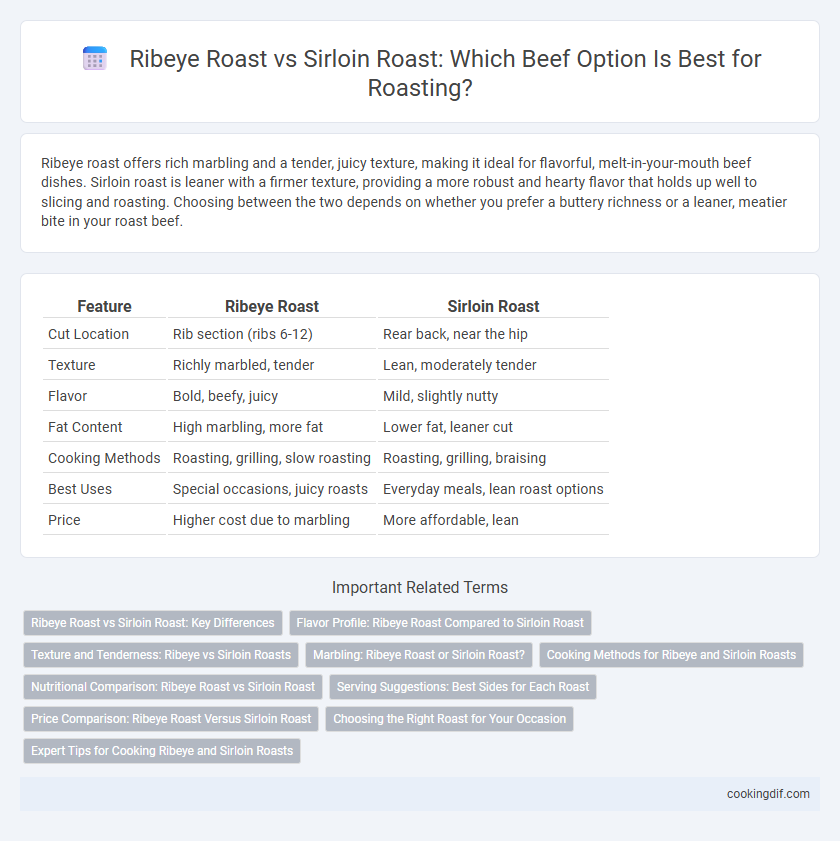Ribeye roast offers rich marbling and a tender, juicy texture, making it ideal for flavorful, melt-in-your-mouth beef dishes. Sirloin roast is leaner with a firmer texture, providing a more robust and hearty flavor that holds up well to slicing and roasting. Choosing between the two depends on whether you prefer a buttery richness or a leaner, meatier bite in your roast beef.
Table of Comparison
| Feature | Ribeye Roast | Sirloin Roast |
|---|---|---|
| Cut Location | Rib section (ribs 6-12) | Rear back, near the hip |
| Texture | Richly marbled, tender | Lean, moderately tender |
| Flavor | Bold, beefy, juicy | Mild, slightly nutty |
| Fat Content | High marbling, more fat | Lower fat, leaner cut |
| Cooking Methods | Roasting, grilling, slow roasting | Roasting, grilling, braising |
| Best Uses | Special occasions, juicy roasts | Everyday meals, lean roast options |
| Price | Higher cost due to marbling | More affordable, lean |
Ribeye Roast vs Sirloin Roast: Key Differences
Ribeye roast features rich marbling and a tender texture, making it ideal for juicy, flavorful cuts, while sirloin roast offers leaner meat with a firmer bite and a slightly beefier taste. Ribeye's high fat content enhances moisture retention during cooking, whereas sirloin roast suits leaner diet preferences but may require careful cooking to avoid dryness. Choosing between ribeye and sirloin roast depends on desired tenderness, flavor intensity, and fat levels in beef options.
Flavor Profile: Ribeye Roast Compared to Sirloin Roast
Ribeye roast offers a rich, well-marbled flavor with a buttery, beefy taste that melts in the mouth, thanks to its higher fat content. Sirloin roast provides a leaner, slightly firmer texture with a robust, savory flavor that is less intense but more balanced than ribeye. The marbling in ribeye enhances juiciness and tenderness, making it ideal for those seeking a decadent beef experience.
Texture and Tenderness: Ribeye vs Sirloin Roasts
Ribeye roast offers a rich marbling that ensures superior tenderness and a juicy, melt-in-the-mouth texture compared to sirloin roast. Sirloin roast tends to be leaner with a firmer texture, making it less tender but ideal for those seeking a meatier bite. The intramuscular fat in ribeye significantly enhances both flavor and softness, setting it apart from the denser sirloin cut.
Marbling: Ribeye Roast or Sirloin Roast?
Ribeye roast features superior marbling compared to sirloin roast, resulting in richer flavor and juicier texture due to the intramuscular fat distribution. Sirloin roast has leaner meat with less marbling, making it a healthier but less tender and flavorful option. For those prioritizing tenderness and succulence, ribeye roast is the optimal choice based on marbling quality.
Cooking Methods for Ribeye and Sirloin Roasts
Ribeye roast excels with high-heat cooking methods like roasting or grilling, which enhance its marbling and tenderness through even heat distribution and fat rendering. Sirloin roast benefits from slower roasting or braising, allowing its leaner cut to become tender without drying out and developing deep, savory flavors. Both roasts can also be reverse-seared to achieve a perfect crust while maintaining juiciness inside.
Nutritional Comparison: Ribeye Roast vs Sirloin Roast
Ribeye roast contains higher fat content, resulting in increased calories and saturated fats compared to sirloin roast, which is leaner and lower in calories. Sirloin roast offers a higher protein-to-fat ratio, making it a better option for those seeking a nutrient-dense, lower-fat beef choice. Both cuts supply essential vitamins like B12 and minerals such as iron, but ribeye's marbling enhances flavor while sirloin emphasizes lean nutrition.
Serving Suggestions: Best Sides for Each Roast
Ribeye roast pairs excellently with rich, creamy sides such as garlic mashed potatoes and sauteed mushrooms, enhancing its marbled, flavorful texture. Sirloin roast is best complemented by lighter, roasted vegetables like Brussels sprouts and carrots, which balance its lean, robust taste. Herb-infused gravy and fresh garden salads work well with both roasts, providing a versatile accompaniment.
Price Comparison: Ribeye Roast Versus Sirloin Roast
Ribeye roast typically commands a higher price per pound compared to sirloin roast due to its rich marbling and tenderness, which enhance flavor and juiciness. Sirloin roast offers a more affordable option while still providing lean meat with moderate tenderness, making it suitable for budget-conscious buyers. The price difference can impact meal planning, with ribeye favored for special occasions and sirloin preferred for everyday meals.
Choosing the Right Roast for Your Occasion
Ribeye roast offers rich marbling and tenderness, making it ideal for special occasions that call for a flavorful, juicy prime cut. Sirloin roast provides a leaner option with robust beef flavor, suited for casual gatherings or when a leaner protein is preferred. Selecting between ribeye and sirloin roasts depends on desired texture, flavor intensity, and dietary preferences for your event.
Expert Tips for Cooking Ribeye and Sirloin Roasts
Ribeye roast offers rich marbling that ensures tenderness and deep flavor, making it ideal for high-heat roasting methods such as searing followed by slow roasting to medium-rare. Sirloin roast, leaner with less fat, benefits from lower temperature roasting or braising to maintain juiciness and enhance its beefy taste. Experts recommend resting both roasts after cooking to allow juices to redistribute, ensuring maximum moisture and flavor retention.
Ribeye roast vs sirloin roast for beef options Infographic

 cookingdif.com
cookingdif.com